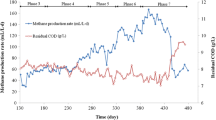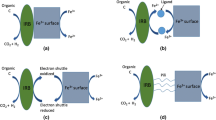Abstract
The effect of biostimulation with ferric oxides, semiconductive ferric oxyhydroxide, and conductive magnetite on the anaerobic digestion of dairy wastewater was examined in a batch mode. The reactors supplemented with ferric oxyhydroxide (R2) and magnetite (R3) showed significantly enhanced biomethanation performance compared with the control (R1). The removal of chemical oxygen demand (COD) after 30 days was 31.9, 59.3, and 82.5 % in R1, R2, and R3, respectively. The consumed COD was almost fully recovered as biogas in R2 and R3, while only 79 % was recovered in R1. The total energy production as biogas was accordingly 32.2, 71.0, and 97.7 kJ in R1, R2, and R3, respectively. The reactors also differed in the acid formation profile with more propionate and butyrate found in R1 and more acetate found in R3. The enhanced biomethanation seems to be associated with variations in the bacterial community structure supposedly induced by the ferric oxides added. In contrast, no evident variation was observed in the archaeal community structure among the reactors. The potential electric syntrophy formed between Methanosaeta concilii-like methanogens and electroactive iron-reducing bacteria, particularly Trichococcus, was likely responsible for the enhanced performance. The stimulated growth of fermentative iron reducers may also have contributed by altering the metabolic characteristics of the bacterial communities to produce more favorable acidogenic products for methanogenesis. The overall results suggest the potential of biostimulation with (semi)conductive ferric oxides to enhance the rate and efficiency of the biomethanation of organic wastes. This seems to be potentially attractive, as increasing attention is being paid to the energy self-sufficiency of waste/wastewater treatment processes today.






Similar content being viewed by others
References
Ahring BK (2003) Biomethanation I, vol. 1. Springer, New York
Akarsubasi AT, Ince O, Kirdar B, Oz NA, Orhon D, Curtis TP, Head IM, Ince BK (2005) Effect of wastewater composition on archaeal population diversity. Water Res 39:1576–1584
APHA-AWWA-WEF (2005) Standard Methods for the Examination of Water and Wastewater, 21st edn. American Public Health Association, Washington, DC
Baek G, Kim J, Lee C (2014) Influence of ferric oxyhydroxide addition on biomethanation of waste activated sludge in a continuous reactor. Bioresour Technol 166:596–601
Bertin L, Lampis S, Todaro D, Scoma A, Vallini G, Marchetti L, Majone M, Fava F (2010) Anaerobic acidogenic digestion of olive mill wastewaters in biofilm reactors packed with ceramic filters or granular activated carbon. Water res 44:4537–4549
Caccavo F, Blakemore RP, Lovley DR (1992) A hydrogen-oxidizing, Fe (III)-reducing microorganism from the Great Bay Estuary, New Hampshire. Appl Environ Microbiol 58:3211–3216
Cheng S, Xing D, Call DF, Logan BE (2009) Direct biological conversion of electrical current into methane by electromethanogenesis. Environ Sci Technol 43:3953–3958
Cruz Viggi C, Rossetti S, Fazi S, Paiano P, Majone M, Aulenta F (2014) Magnetite particles triggering a faster and more robust syntrophic pathway of methanogenic propionate degradation. Environ Sci Technol 48:7536–7543
De Vos P, Garrity GM, Jones D, Krieg NR, Ludwig W, Rainey FA, Schleifer K-H, Whitman WB (2009) In: Bergey’s Manual of Systematic Bacteriology, vol Vol. 3: The Firmicutes, 2nd edn. Springer, New York
Dinh HT, Kuever J, Muszmann M, Hassel AW, Stratmann M, Widdel F (2004) Iron corrosion by novel anaerobic microorganisms. Nature 427:829–832
Fernandez A, Huang S, Seston S, Xing J, Hickey R, Criddle C, Tiedje J (1999) How stable is stable? Function versus community composition. Appl Environ Microbiol 65:3697–3704
Fox JR, Mortimer RJ, Lear G, Lloyd JR, Beadle I, Morris K (2006) The biogeochemical behavior of U (VI) in the simulated near-field of a low-level radioactive waste repository. Appl Geochem 21:1539–1550
Hammer O, Harper DAT, Ryan PD (2001) PAST: Palaeontological statistics software package for education and data analysis. Palaeontol Electron 4:1–9
Hwang S, Hansen C (1998) Characterization of and bioproduction of short-chain organic acids from mixed dairy-processing wastewater. Trans ASAE 41:795–802
Ivanov VN, Stabnikova EV, Stabnikov VP, Kim IS, Zubair A (2002) Effects of iron compounds on the treatment of fat-containing wastewaters. Appl Biochem Microbiol 38:255–258
Jabari L, Gannoun H, Cayol J-L, Hedi A, Sakamoto M, Falsen E, Ohkuma M, Hamdi M, Fauque G, Ollivier B, Fardeau M-L (2012) Macellibacteroides fermentans gen. Nov., sp. nov., a member of the family Porphyromonadaceae isolated from an upflow anaerobic filter treating abattoir wastewaters. Int J Syst Evol Microbiol 62:2522–2527
Kato S, Hashimoto K, Watanabe K (2012) Methanogenesis facilitated by electric syntrophy via (semi)conductive iron-oxide minerals. Environ Microbiol 14:1646–1654
Khanal SK, Chen W-H, Li L, Sung S (2004) Biological hydrogen production: effects of pH and intermediate products. Int J Hydrogen Energ 29:1123–1131
Kim J, Jung H, Lee C (2014a) Shifts in bacterial and archaeal community structures during the batch biomethanation of Ulva biomass under mesophilic conditions. Bioresour Technol 169:502–509
Kim J, Lee S, Lee C (2013) Comparative study of changes in reaction profile and microbial community structure in two anaerobic repeated-batch reactors started up with different seed sludges. Bioresour technol 129:495–505
Kim S-J, Park S-J, Cha I-T, Min D, Kim J-S, Chung W-H, Chae J-C, Jeon CO, Rhee S-K (2014b) Metabolic versatility of toluene-degrading, iron-reducing bacteria in tidal flat sediment, characterized by stable isotope probing-based metagenomic analysis. Environl Microbiol 16:189–204
Kitahara M, Sakamoto M, Tsuchida S, Kawasumi K, Amao H, Benno Y, Ohkuma M (2013) Parabacteroides chinchillae sp. nov., isolated from chinchilla (Chincilla lanigera) feces. Int J Syst Evol Microbiol 63:3470–3474
Kobayashi T, Yasuda D, Li Y-Y, Kubota K, Harada H, Yu H-Q (2009) Characterization of start-up performance and archaeal community shifts during anaerobic self-degradation of waste-activated sludge. Bioresour Technol 100:4981–4988
Lay J-J, Li Y-Y, Noike T (1998) Developments of bacterial population and methanogenic activity in a laboratory-scale landfill bioreactor. Water Res 32:3673–3679
Lee C, Kim J, Shin SG, O’Flaherty V, Hwang S (2010) Quantitative and qualitative transitions of methanogen community structure during the batch anaerobic digestion of cheese-processing wastewater. Appl Microbiol Biotechnol 87:1963–1973
Liu F, Rotaru A-E, Shrestha PM, Malvankar NS, Nevin KP, Lovley DR (2015) Magnetite compensates for the lack of a pilin-associated c-type cytochrome in extracellular electron exchange. Environ Microbiol 17:648–655
Lovely D, Phillips EJP (1987) Rapid assay for microbially reducible ferric iron in aquatic sediments. Appl Environ Microbiol 53:1536–1540
Lovley D (2006) Dissimilatory Fe(III)- and Mn(IV)-Reducing Prokaryotes. In: Dworkin M, Falkow S, Rosenberg E, Schleifer K-H, Stackebrandt E (eds) The Prokaryotes. Springer, New York, pp. 635–658
Lovley DR (1991) Dissimilatory Fe(III) and Mn(IV) reduction. Microbiol Rev. 55:259–287
Lovley DR, Phillips EJ, Lonergan DJ (1989) Hydrogen and formate oxidation coupled to dissimilatory reduction of iron or manganese by Alteromonas putrefaciens. Appl Environ Microbiol 55:700–706
Lovley DR, Phillips EJP (1989) Requirement for a microbial consortium to completely oxidize glucose in Fe(III)-reducing sediments. Appl Environ Microbiol 55:3234–3236
Mamais D, Pitt PA, Cheng YW, Loiacono J, Jenkins D (1994) Determination of ferric chloride dose to control struvite precipitation in anaerobic sludge digesters. Water Environ Res 66:912–918
McCune B, Grace JB (2002) Analysis of Ecological Communities. Vol. 2. Glenden Beach, OR: MjM Software Design, USA.
Morita M, Malvankar NS, Franks AE, Summers ZM, Giloteaux L, Rotaru AE, Rotaru C, Lovley DR (2011) Potential for direct interspecies electron transfer in methanogenic wastewater digester aggregates. MBio 2:e00159–e00111
Muyzer G, De Waal EC, Uitterlinden AG (1993) Profiling of complex microbial populations by denaturing gradient gel electrophoresis analysis of polymerase chain reaction-amplified genes coding for 16S rRNA. Appl Environ microbiol 59:695–700
Qu D, Ratering S, Schnell S (2004) Microbial reduction of weakly crystalline iron (III) oxides and suppression of methanogenesis in paddy soil. Bull Environ Contam Toxicol 72:1172–1181
Quéméneur M, Hamelin J, Barakat A, Steyer J-P, Carrère H, Trably E (2012) Inhibition of fermentative hydrogen production by lignocellulose-derived compounds in mixed cultures. Int J Hydrogen Energ 37:3150–3159
Roden EE, Wetzel RG (2003) Competition between Fe(III)-reducing and methanogenic bacteria for acetate in iron-rich freshwater sediments. Microb Ecol 45:252–258
Rotaru A-E, Shrestha PM, Liu F, Shrestha M, Shrestha D, Embree M, Zengler K, Wardman C, Nevin KP, Lovley DR (2014) A new model for electron flow during anaerobic digestion: direct interspecies electron transfer to Methanosaeta for the reduction of carbon dioxide to methane. Energ Environ Sci 7:408–415
Scott JP (1926) A method of increasing the virulence of Clostridium chauvoei by the use of ferric salts. J Infect Dis 38:511–513
Seifert K, Waligorska M, Wojtowski M, Laniecki M (2009) Hydrogen generation from glycerol in batch fermentation process. Int J Hydrogen Energ 34:3671–3678
Smith KS, Ingram-Smith C (2007) Methanosaeta, the forgotten methanogen? Trends Microbiol 15:150–155
Supaphol S, Jenkins SN, Intomo P, Waite IS, O’Donnell AG (2011) Microbial community dynamics in mesophilic anaerobic co-digestion of mixed waste. Bioresour Technol 102:4021–4027
Tan H-Q, Li T-T, Zhu C, Zhang X-Q, Wu M, Zhu X-F (2012) Parabacteroides chartae sp. nov., an obligately anaerobic species from wastewater of a paper mill. Int J Syst Evol Microbiol 62:2613–2617
Tandukar M, Huber SJ, Onodera T, Pavlostathis SG (2009) Biological chromium (VI) reduction in the cathode of a microbial fuel cell. Environ Sci Technol 43:8159–8165
Uchiyama T, Ito K, Mori K, Tsurumaru H, Harayama S (2010) Iron-corroding methanogen isolated from a crude-oil storage tank. Appl Environ Microbiol 76:1783–1788
Ueno Y, Sasaki D, Fukui H, Haruta S, Ishii M, Igarashi Y (2006) Changes in bacterial community during fermentative hydrogen and acid production from organic waste by thermophilic anaerobic microflora. J Appl Microbiol 101:331–343
Van Bodegom PM, Scholten JCM, Stams AJM (2004) Direct inhibition of methanogenesis by ferric iron. FEMS Microbiol Ecol 49:261–268
VandeWalle JL, Goetz GW, Huse SM, Morrison HG, Sogin ML, Hoffmann RG, Yan K, McLellan SL (2012) Acinetobacter, Aeromonas and Trichococcus populations dominate the microbial community within urban sewer infrastructure. Environ Microbiol 14:2538–2552
Venetsaneas N, Antonopoulou G, Stamatelatou K, Kornaros M, Lyberatos G (2009) Using cheese whey for hydrogen and methane generation in a two-stage continuous process with alternative pH controlling approaches. Bioresour Technol 100:3713–3717
Wicher E, Seifert K, Zagrodnik R, Pietrzyk B, Laniecki M (2013) Hydrogen gas production from distillery wastewater by dark fermentation. Intl J Hydrogen Energ 38:7767–7773
Yamada C, Kato S, Ueno Y, Ishii M, Igarashi Y (2015) Conductive iron oxides accelerate thermophilic methanogenesis from acetate and propionate. J Biosci Bioeng 119:678–682
Yu Y, Lee C, Kim J, Hwang S (2005) Group-specific primer and probe sets to detect methanogenic communities using quantitative real-time polymerase chain reaction. Biotechnol Bioeng 89:670–679
Zhang D, Chen Y, Zhao Y, Zhu X (2010) New sludge pretreatment method to improve methane production in waste activated sludge digestion. Environ Sci Technol 44:4802–4808
Zumstein E, Moletta R, Godon J (2000) Examination of two years of community dynamics in an anaerobic bioreactor using fluorescence polymerase chain reaction (PCR) single-strand conformation polymorphism analysis. Environ Microbiol 2:69–78
Acknowledgments
This research was supported by the National Research Foundation of Korea (NRF) through Basic Science Research Program (2014R1A1A1002329) granted by the Ministry of Science, ICT, and Future Planning and also through International Cooperation Program managed by NRF (2013K2A1A2054369). The authors are also grateful for the support of the Korea Ministry of Environment (MOE) through a Waste-to-Energy Human Resource Development Project.
Conflict of interest
The authors declare that they have no conflict of interest.
Ethical statement
This article does not contain any studies with human participants or animals performed by any of the authors.
Author information
Authors and Affiliations
Corresponding author
Rights and permissions
About this article
Cite this article
Baek, G., Kim, J., Cho, K. et al. The biostimulation of anaerobic digestion with (semi)conductive ferric oxides: their potential for enhanced biomethanation. Appl Microbiol Biotechnol 99, 10355–10366 (2015). https://doi.org/10.1007/s00253-015-6900-y
Received:
Revised:
Accepted:
Published:
Issue Date:
DOI: https://doi.org/10.1007/s00253-015-6900-y




